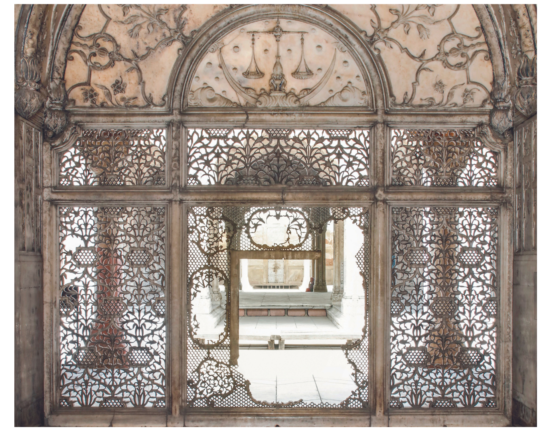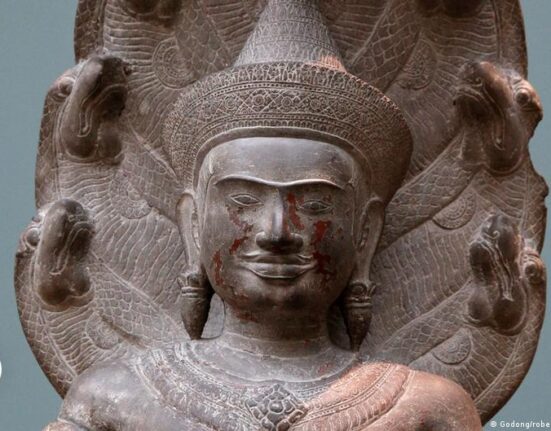The Finding of Moses stands as one of Sir Lawrence Alma- Tadema’s greatest masterpieces (est. $3/5 million). In November 1902, the artist left London to travel to Egypt for the opening of the Aswan Dam as a guest of Sir John Aird, the renowned engineer and head of the project. In his personal life, Aird was known as a great patron of the arts, and he likely brought Alma-Tadema on this trip to commission another painting from the artist for his collection. Alma-Tadema in turn found himself as inspired by Egypt as he had been 50 years earlier in his travels to Pompeii. He provided Aird with three subject options, from which he quickly chose The Finding of Moses. The painting once belonged to Allen Funt, creator of the popular prank show Candid Camera. His collection of masterworks by Alma-Tadema was exhibited in a landmark show at the Metropolitan Museum of Art in 1973. If the setting of The Finding of Moses looks familiar, it is because prints of the painting were later used by Cecil B. DeMille’s script writer and designers as inspiration for scenes from Cleopatra (1934) and The Ten Commandments (1956).
After the Bath is among the most accomplished examples of a series of bath scenes that Jean-Léon Gérôme painted beginning in the 1870s (est. $1.5/2.5 million). In the work, a group of female bathers gather around a reflective pool in a harem. Their forms demonstrate Gérôme’s careful examination of the human body and its skeletal structure, subtle muscle movement and textured skin. The sale of this painting coincides with The Spectacular Art of Jean- Léon Gérôme, a major show that was featured at the Getty Museum over the summer of 2010 and opens at the Musée d’Orsay in October.
Ludwig Deutsch is today one of the most recognized Orientalist painters of the nineteenth century, acclaimed for his highly-detailed, exquisitely rendered images of daily life in Cairo (est. $600/800,000). He painted The Inspection in his Paris studio after his first expedition to Egypt in 1883, a trip he made as many as four additional times through 1904. The work, which shows an Arab man examining a late Indian or Qajar Iranian helmet, is a visual tour de force that showcases the artist’s skill and attention to detail. The dazzling barrage of objects and textiles–patterns against patterns, details within details– conveys Deutsch’s fascination with Eastern visual culture.
Giovanni Boldini is represented in the sale by two excellent portraits. Portrait of Giovinetta Errazuriz shows the daughter of Madame Josephina Alvear de Errazuriz, a prominent Chilean expatriate living in Paris in the 1890s (est. $1/1.5 million). The work has a level of individuality and personality that was seldom accorded to children in contemporary portraiture, though the inch of thigh shown on Giovinetta caused a damaging scandal when the painting was exhibited at the Venice Biennale in 1897. This work was a highlight of the 2010 exhibition Boldini in Impressionist Paris at the Sterling and Francine Clark Art Institute in Williamstown, Massachusetts. Portrait of the Artist Lawrence Alexander (“Peter”) Harrison is among the most distinguished and sophisticated of Boldini’s male portraits (est. $1/1.5 million). The brilliant use of space creates the illusion that Harrison’s imposing figure cannot be contained by the boundaries of the canvas.
Also in the sale are two works by Jean Béraud from a European Private Collection. Béraud was intrigued by all aspects of Parisian life, and as a painter he was a scrupulous and devoted observer, the quintessential chronicler of Belle Époque Paris. To create his finished paintings, the artist traveled the boulevards of Paris in a mobile studio, a converted carriage designed so that he might observe the mundane, transient incidents of city life first-hand. Avenue Parisienne shows a particularly bustling day on a classic Parisian boulevard (est. $700,000/1 million). Distinctive characters occupy the scene, and their detachment from each other invites the viewer to become engaged mis-en-scène. In Place de l’Europe, Béraud records the spectacles of a changing Paris from one of the grand vistas created by Baron Haussmann’s radical and extensive redesign of the city in the 1870s (pictured above, est. $700,0000/1 million). From the approach to Gare St. Lazare, a site immortalized in works by other artists including Manet, Monet and Caillebotte, Béraud was able to experiment with a more modern style, a departure from the artist’s trademark traditionalism.
Sporting Art in the sale is led by Sir Alfred James Munnings’s Portrait of Miss Patricia Grace on a Pony (est. $400/600,000). Upon traveling to Long Island in 1924 to paint the portraits of the American polo team, Munnings became enamored by the sophisticated, friendly people he met. Among them was William Russell Grace, whose daughter Patricia the artist found very charming. He painted Patricia on her pony Athenee in his iconic style, rendering the horse and rider in the finest detail while giving the surrounding vignettes a hazier focus, and conveyed the sweet and gentle nature of both Patricia and her trusted mount.
Works by Spanish painters in the sale are highlighted by Grupas Valencianas (Valencian Girls), a painting by Hermen Anglada- Camarasa, one of the most influential and innovative Spanish artists of the early twentieth century whose complex choromatic schemes and bold use of decorative patterns influenced a generation of modern artists including Kandinsky and Picasso (est. $500/700,000). The artist left Spain to study in Paris in 1894, but returned ten years later to Valencia, an ancient yet rapidly modernizing city whose culture was influenced by its people’s European and Middle Eastern heritage. Valencian Girls is one of approximately fifteen masterworks from the artist’s time there, painted not necessarily to record fading local rituals, but instead to capture the brilliant colors of the elaborate costumes and poses of the participants.
French artists known for their movement towards realism at a time when romanticism was the dominant European style include Jules Dupré and Jean-François Millet. Dupré painted his Environ de Southampton (Angleterre) at the age of 24 and with nearly no formal training (pictured right, est. $600/800,000). It exemplifies the type of strong landscape with sharp colors that would establish his early leadership within the Barbizon school. Millet’s Le Grand Frère, last seen in public in 1875, marks an undisputable high point in the pastel oeuvre of an artist rightfully celebrated as a master painter of the peasant (pictured left, est. $300/400,000). Millet’s landmark 1875 exhibition of pastels moved Vincent van Gogh to deem the site “holy ground,” and allegedly prompted Edgar Degas to turn to the pastel medium.
The sale also offers a painting by Józef Brandt, a leading Polish artist whose work is rare on the market. Zaporozcy was painted at the height of Brandt’s popularity, and exemplifies his bold vivid palette and confident handling of the paint medium (est. $280/320,000). While many of his pieces from the late-nineteenth century depicted battle scenes, several of Brandt’s masterful works illustrate the quieter moments of military life. In Zaporozcy, a buyer considers a horse that is being ridden for his review, set against the background of a Cossack military camp on the open plains of the seventeenth century Polish Republic.






